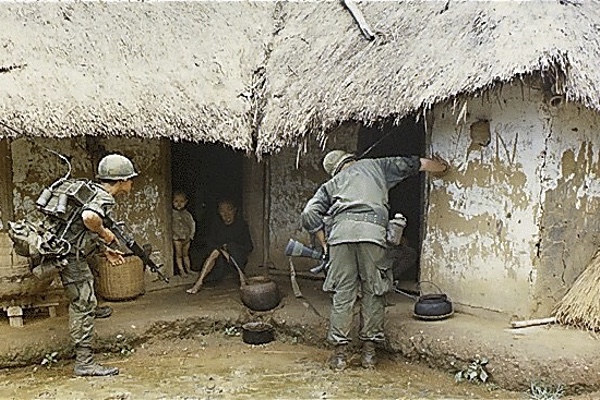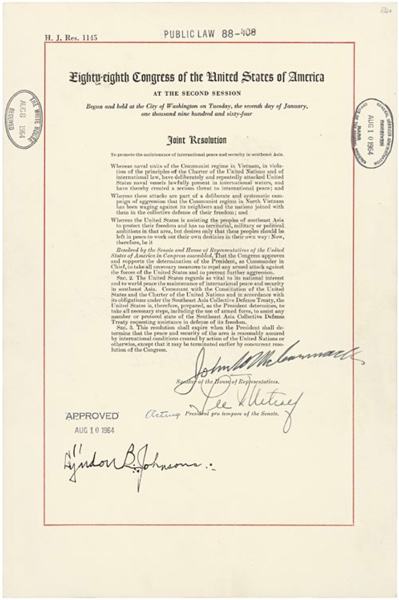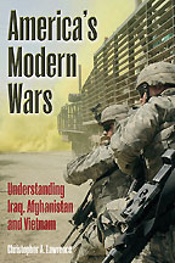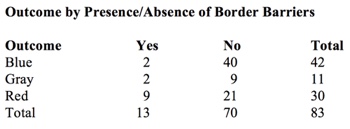Did the Pentagon Learn from Vietnam?

On 2 August 1964, a United States destroyer engaged North Vietnamese patrol boats in the Gulf of Tonkin, off the coast of North Vietnam. On 7 August 1964, President Johnson was able to railroad the “Gulf of Tonkin Resolution” through the Congress, authorizing him to use armed forces to assist in Southeast Asia. On 8 March 1965, two battalions of U.S. Marines landed on a beach near Da Nang in South Vietnam. By the end of 1965, the United States had 184,000 troops deployed in Vietnam. So started America’s commitment to a war that turned into the largest and bloodiest insurgency in history. Before 1965, it had cost 257 American lives. Before the war was done some 58,000 Americans had died.

The Gulf of Tonkin Resolution, 10 August 1964.
In May 1965 the Advanced Research Projects Agency (now called DARPA) awarded a contact to the nascent research company, the Historical Evaluation and Research Organization (HERO), headed by retired Colonel Trevor N. Dupuy. He, his staff, and his consultants examined 20 historical cases of guerrilla wars to assess the problem of how to isolate insurgent fighters from internal and external support. Twenty-seven people were credited as participants in the study including Trevor Dupuy himself, his father the historian and journalist R. Earnest Dupuy, historian and journalist Marshall Andrews, political scientist Andrew C. Janos, and historians Peter Paret, John Shy, Gunther Rothenberg and Theodore Ropp. This was an impressive cast of reputable and talented scholars. This study, called “Isolating the Guerrilla,” was completed on 1 February 1966.
We do not know how this study was received, who reviewed it or what action was taken in response to it. We do not know if it shaped U.S. policy or simply sat on a shelf. Trevor Dupuy never mentioned the study during the time I worked for him and knew him (1987-1995). I never saw a copy of it. The study was classified at the time it was submitted, even though it was developed from unclassified historical data. Colonel Dupuy’s copy was destroyed when HERO went out of the business during the defense cuts of the early 1990s. Founded in 1992, The Dupuy Institute has copies of almost all of the 130 reports that Trevor Dupuy’s previous organizations had done, but it did not have a copy of this one.
 “Isolating
the Guerrilla” was commissioned at the height of U.S. government
support for social science research on countering insurgency.
Increasing involvement in thwarting a Communist takeover of Vietnam
through the late 1950s and early 1960s led to intense interest within
the American national security establishment about the nature and
character of insurgent and guerrilla warfare. The Defense Department
and Army funded an array of researchers and organizations, including
government sponsored Federal Contract Research Centers like RAND,
Research and Analysis Corporation (RAC), Institute for Defense
Analysis (IDA), Center for Naval Analysis (CNA), and the Special
Operations Research Office (SORO) as well as scholars and
universities, and non-governmental organizations like HERO.
Several individuals, some with experience fighting guerrillas in the
1940s and 1950s—including Roger Trinquier, David Galula, Richard
Clutterbuck, Bernard Fall, and Frank Kitson—published books
offering analysis and insights. By the late 1960s, however, much of
the government research funding dried up due to public relations
missteps, mounting anti-war sentiment, and a growing desire by the
military establishment to put the painful and complicated Vietnam War
experience behind it. Many promising lines of research were abandoned
unfinished and soon to be forgotten, until the United States faced
similar challenges in Afghanistan and Iraq in the early 21st
century.1
“Isolating
the Guerrilla” was commissioned at the height of U.S. government
support for social science research on countering insurgency.
Increasing involvement in thwarting a Communist takeover of Vietnam
through the late 1950s and early 1960s led to intense interest within
the American national security establishment about the nature and
character of insurgent and guerrilla warfare. The Defense Department
and Army funded an array of researchers and organizations, including
government sponsored Federal Contract Research Centers like RAND,
Research and Analysis Corporation (RAC), Institute for Defense
Analysis (IDA), Center for Naval Analysis (CNA), and the Special
Operations Research Office (SORO) as well as scholars and
universities, and non-governmental organizations like HERO.
Several individuals, some with experience fighting guerrillas in the
1940s and 1950s—including Roger Trinquier, David Galula, Richard
Clutterbuck, Bernard Fall, and Frank Kitson—published books
offering analysis and insights. By the late 1960s, however, much of
the government research funding dried up due to public relations
missteps, mounting anti-war sentiment, and a growing desire by the
military establishment to put the painful and complicated Vietnam War
experience behind it. Many promising lines of research were abandoned
unfinished and soon to be forgotten, until the United States faced
similar challenges in Afghanistan and Iraq in the early 21st
century.1
In 2004, The Dupuy Institute was again working on insurgencies, in particular Iraq. This work included developing a large database of 109 post-World War II insurgencies, peacekeeping operations and interventions. In 2006 The Dupuy Institute was contracted to test the theories of nine counterinsurgency experts’ theories against the data that the Institute had collected.2 This did not include Trevor Dupuy’s work. At that time, I looked through the files we had dating back to 1962, and could only find seven reports that had been done by HERO on insurgencies, but we did not have a copy of “Isolating the Guerrilla.”
As we were finishing much of our contracted work, I was contacted by Michael F. Trevett. It turns out that the report “Isolating the Guerrilla” had been declassified in October 2004. He had found it in a library at Ft. Huachuca, Arizona. This was an army base not far from Tombstone and the site of the Battle of the OK Corral, but very far from the decision-making centers in Washington, D.C. As Lt. Colonel Trevett states: “Thousands of lives could have been saved in Iraq and Afghanistan had political and military leaders been educated on the information in and findings of Isolating the Guerrilla.”3 He brought me a copy of this report in 2008 and then proceeded to publish it in 2011 at his own expense so that it would be available to the world.
Meanwhile, as the U.S. commitment in the wars in Iraq and Afghanistan declined, our insurgency work ended. I then put pen to paper and decided to write my own book on insurgencies, America’s Modern Wars: Understanding Iraq, Afghanistan and Vietnam. Published in February 2015, it included a chapter called “Other Theorists,” where we compare our quantitative analysis to the theories of nine counterinsurgency theorists. As this was the work we had already done under contract, it did not include Trevor Dupuy’s study.
So, with my book published, and the wars in Iraq and Afghanistan still not resolved, I decided to finally systematically review “Isolating the Guerrilla.” I analyzed and coded it in the same manner as we did for the nine counterinsurgent theorists in Chapter 17 of my book, and as we did for the writings of eight insurgents in Chapter 18 (“The Other Side”) of my book. It was a straightforward effort as we had already done this 17 times before, with the only challenge being to objectively evaluate the report, as it was done by our parent organization and by my mentor.
In the original effort we conducted our evaluation based upon specific subject areas (for example: the area of a country). Furthermore, we examined each work and tried to identify if the theorist proposed an over-arching theory on insurgencies. Surprisingly, most of these works did not have one. So how did “Isolating the Guerrilla” compare?
First, this report from the beginning had the purpose to “suppress guerrillas by isolating them from internal and external support.”4 This was in accordance with the HERO proposal that resulted in the contract award. As such, it was not a theoretical effort that determined why an insurgency succeeded or failed, unlike my work. It was more specifically oriented towards answering a specific question, which is how to isolate the insurgent. As the study notes: “The report presents a tentative “theory of isolation.” It is stressed, however, that this is only one aspect of a much larger requirement for the United States to develop practical overall theory, doctrine, and organization to deal with the new challenge.”5
Isolation in this case refers to two different subjects. First is external isolation, meaning isolating the guerrilla from outside sources of supply, such as the aid coming from North Vietnam, China, Russia and Eastern Europe during the Vietnam War. The second subject is internal isolation, isolating the guerrilla from the population in which he lives, collects taxes from, and that protects and nurtures him.
The Dupuy Institute’s analysis of external isolation yielded some odd and intellectually contradictory answers. To pull a chart from my book:6

What this means is that of the 83 cases we tested, in only 14 cases the insurgencies had “considerable” outside support. Of those 14 cases, the counterinsurgents (blue) won 9 times while the insurgents (red) won 5 times. On the other hand, in those 23 cases where the insurgency was judged to be “primarily indigenous,” the counterinsurgents (blue) won 11 times while the insurgents (red) won 7 times. This is close to the same percentage of wins whether the insurgents had considerable outside support or did not. Our statistical tests indicated that there was no correlation here.7 Therefore we were not left with a clear indication that isolating a well established and broadly supported insurgency from outside support clearly doomed it. This led us to examine the underlying cause of the insurgency, which we felt was more relevant than the amount of aid that they received.
The “Isolating the Guerrilla” study makes the very qualifying statement that “An insurgent guerrilla force eventually must receive sufficient outside moral support to obtain general or de facto recognition.”8 Nothing in the report seems to indicate that this is necessary for the insurgency to develop. As such, it does not appear to be a disagreement in our two expressed viewpoints, even though they do not quite match each other. That stated, three of the recommendations made relevant to the Vietnam War concerned external support.
“Isolating the Guerrilla” provided four recommendations for Vietnam. They were: 1) examine the feasibility of establishing a barrier strip along the South Vietnam borders, 2) send a force into southern Laos to interdict external support, 3) undertake covert long-range penetration raids into North Vietnam, and 4) adopt a policy of employing temporarily incapacitating chemical and biological agents.9 I believe the first recommendation would have been useful, especially in conjunction with the second recommendation. The problem in the case of Vietnam was finding the manpower to effectively cover this potentially 160 mile barrier.10 Regarding the third and fourth recommendations, I strongly disagree with their effectiveness, especially considering all the ramifications of such approaches. In the case of long-range covert penetration raids into North Vietnam, the U.S. instead subjected the country to a long-term strategic air campaign that dropped more bombs on Vietnam than it did on Germany in World War II. This did not appear to have turned the war to our favor. In the case of the fourth point, the U.S. did make use of tear gas in clearing tunnels and other such areas, and did make extensive use of defoliates to clear the jungle and operation areas of the insurgents. This last effort also appears to have created long-term health problems for some of our own troops (i.e. Agent Orange). The use of “incapacitating chemical and biological agents” for the purpose of isolating the population from the guerrilla was not tried, and really never had been as part of any counterinsurgency campaign.11 It may have been this recommendation though that led to the report being classified, even though it was work developed from an analysis of history.
The issue of border barriers is a case where we obtained a negative result. To again pull a table from my book:12

What this chart indicates is that of the 13 cases where the counterinsurgents used border barriers, the insurgents (the red side) won in 69% of the cases. On the other hand, in the cases where border barriers were not used, the counterinsurgents won in 57% of the cases. This is not a strong endorsement of the value of border barriers.
Our Analysis of Counterinsurgency Theorists
Our analysis of the nine counterinsurgency theorists examined their positions on 1) Terrain and Geographic Considerations, 2) Rules of Engagement and Degrees of Brutality, 3) Force Ratios, 4) Nature of Insurgencies, 5) Measurements of Burden, 6) Operational Details and then we created a 7) a final score card. Below I have summarized the comparison of Trevor Dupuy’s work on insurgencies to The Dupuy Institute’s work on insurgencies, using the same scorecard system as discussed in my book on pages 200-201:

The Dupuy Institute Isolating the Guerrilla
In our work, we found that Galula and Fall were closest in agreement with our work. “Isolating the Guerrilla” is not in close agreement with our work, in part because it did not fully explore the range of issues that our work did. As such, its rating is similar to the rating we gave to views presented by Clutterbuck, the BDM report, Kitson and Joes.
The study also offered a greater theoretical construct on isolating the guerrilla from local and/or external support and included an entire chapter presenting a theory of isolation.15 This was clearly the larger piece of analysis that they wanted to do and obtain further funding for.16 The study was clearly constrained as to scope as the contract limited the study to “suggest means to separate…guerrillas from the rest of the population” and to “suggest workable responses to outside support.” One notes that there was never any follow-up or additional study done on this at HERO. This is not dissimilar to our own experience, which is discussed in some depth in my book.17
This, of course, harkens back to the bigger problem of obtaining funding for any research project that is by it nature, a labor-intensive long-term process. It is easy to get funding when a subject is sexy, but becomes damn near impossible once a subject becomes passé. In the environment of the Department of Defense (DOD), a subject can go from sexy to passé in a couple of years. In many cases, a subject becomes passé when the DOD thinks it has developed an answer and has moved forward with action. This was the case with Vietnam, where during the 1960s there were considerable studies and analysis (and funding) for subjects like insurgencies and causes of revolutions, and virtually nothing after that. Vietnam was the bloodiest guerrilla war in modern history, and when it ended the United States military never really conducted any significant studies of the failed war. This shortfall showed up in spades when we entered Afghanistan and Iraq, and was paid for by American lives.
------
1 The U.S. government’s role in funding basic research during the Vietnam War era is recounted in Seymour J. Deitchman, The Best-Laid Schemes: A Tale of Social Research and Bureaucracy (The MIT Press, Cambridge, Mass., 1976); Mai Elliot, RAND in Southeast Asia: A History of the Vietnam War Era (RAND Corporation: Santa Monica, CA, 2010); Charles R. Shrader, History of Operations Research in the United States Army, Vol. II: 1961-1973 (Office of the Deputy Undersecretary of the Army for Operations Research, U.S. Army, Washington, D.C., 2008); and Andrew J. Birtle, U.S. Army Counterinsurgency and Contingency Operations Doctrine, 1942-1976 (Center of Military History, United States Army, Washington, D.C. 2006). Also see A History of the Department of Defense Federally Funded Research and Development Centers, (U.S. Congress Office of Technology Assessment, Washington, D. C., 1995), which was primarily written by this author.
2 These experts were Manwaring, Trinquier, Joes, Galula, Clutterbuck, Fall, Kitson, O’Neill and a BDM report by Blaufarb and Tanham. A listing of their full names and their works that were examined can be found in my book America’s Modern Wars: Understanding Iraq, Afghanistan and Vietnam (Casemate Publishers, Philadelphia & Oxford, 2015).
3 Michael F. Trevett, Isolating the Guerrilla (Tate Publishing, Mustang, Oklahoma, 2011). page 24.
4 Isolating the Guerrilla, page 35. Note that these footnotes reference the report by name in those cases where the ideas expressed are from the report prepared by Trevor N. Dupuy and associates. The page numbers are from Michael F. Trevetts, Isolating the Guerrilla.
5 Isolating the Guerrilla, page 41.
6 See Christopher A. Lawrence, America’s Modern Wars: Understanding Iraq, Afghanistan and Vietnam (Casemate Publishers, Philadelphia & Oxford, 2015), page 79.
7 The two-sided p-value from Fisher’s exact test excluding the not applicable cases: 0.8527. The two-sided p-value from Fisher’s exact test excluding the not applicable and gray cases: 0.6624. Gray cases are those that we could not adjudicate as to a winner or loser, because it was either drawn, on-going, or there was not otherwise a clear result.
8 Isolating the Guerrilla, pages 38.
9 It is interesting to note that not all of the study’s authors endorsed these recommendations. Col Dupuy, with the approval of HERO’s Policy Advisory Committee, took full responsibility for them. See Isolating the Guerrilla, pages 163 and 448, footnote 19. We did reach out to Peter Paret for comment, but he was not involved in the reports’ conclusions.
10 This issue is discussed in depth in my book America’s Modern Wars, Chapter 22 “Relating a Force Ratio Model to Vietnam”, pages 279-282.
11 Iraq under Saddam Hussein did employ chemical and biological agents against his Kurdish rebellions as did Bashir Assad against the rebels in Syria.
12 America’s Modern Wars, page 107. This Fisher’s exact test p-value is 0.0090.
13 The low correlation in viewpoint is primarily because it is not discussed in Isolating the Guerrilla. The same is the case with the “Nature” of an insurgency.
14 This is tentative. It appears that the report endorses force ratio as a factor, but puts in so many qualifying statements that one is left to wonder.
15 Isolating the Guerrilla, pages 149-159.
16 Isolating the Guerrilla, page 163.
17 See America’s Modern War, pages 294 - 296.